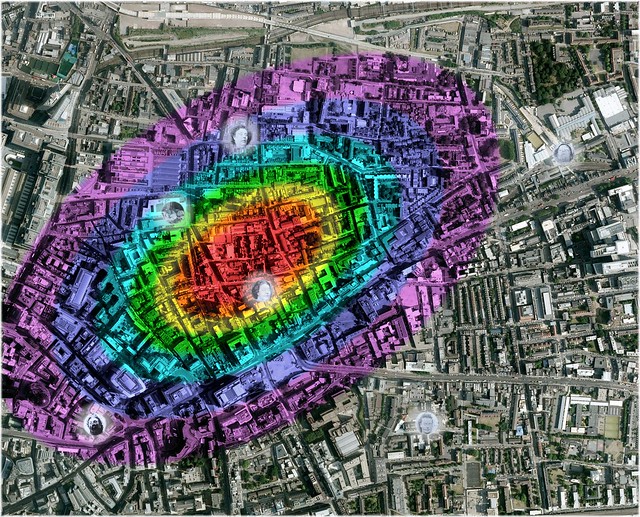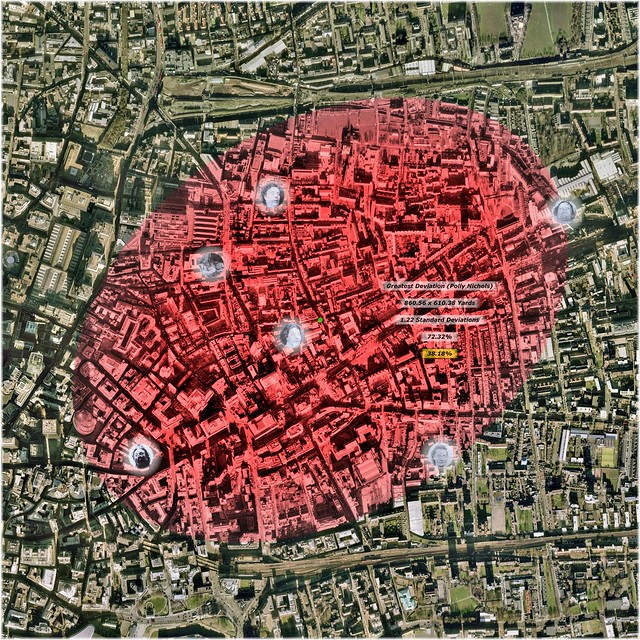Originally posted by m_w_r
View Post
I didn't understand your question, initially. But, now I think I know what's on your mind.
If, for instance, a geographic-profile probability distribution were to extend across the River Thames, should the portion of that distribution that actually covered the river, be re-allocated elsewhere? And, should the dispersion of the overall distribution's density be adjusted accordingly?
Ideally, ... yes!
Ideally!
But, such an endeavor would be extremely tricky, to say the least!
~~~
Please bear in mind that my sole purpose, within the realm of this particular discussion, is the conveyance of the most fundamental principles of a probability distribution, as they would apply to geographic criminal profiling.
The overwhelming majority of 'Ripperologists', I am afraid, ...

Hypothetical Probability Distribution (Elliptical) (Click Image, to Enlarge in flickr)
Underlying Aerial Imagery: Copyright Google Earth, 2010
Overlying Plots, Labels and Color-Shadings: Copyright Colin C. Roberts, 2011
... would quickly glance at this hypothetical geographic-profile probability distribution, and assume that it suggested that 'Jack the Ripper' probably resided at the center of the red color-shaded isopleth.
Remember my description of the overall distribution, on a cumulative basis:
Red: 10.00%
Red, Orange: 20.00%
Red, Orange, Yellow: 30.00%
Red, Orange, Yellow, Green: 40.00%
Red, Orange, Yellow, Green, Aqua: 50.00%
Red, Orange, Yellow, Green, Aqua, Blue: 60.00%
Red, Orange, Yellow, Green, Aqua, Blue, Purple: 70.00%
---
Not Depicted: 70.01% - 100.00%
In other words:
In the red color-shaded isopleth, we have an ellipse that is concentric and proportional to each of the other color-shaded isopleths, that contains an accumulation of ... ten percent of the overall distribution of either raindrops, or probability.
In the red and orange color-shaded isopleths, we have an ellipse that is concentric and proportional to each of the other color-shaded isopleths, that contains an accumulation of ... twenty percent of the overall distribution of either raindrops, or probability.
In the red, orange and yellow color-shaded isopleths, we have an ellipse that is concentric and proportional to each of the other color-shaded isopleths, that contains an accumulation of ... thirty percent of the overall distribution of either raindrops, or probability.
Etc.
So ...
Originally posted by Colin Roberts
View Post
Red, Orange, Yellow, Green, Aqua, plus ... let's say ... one square-millimeter, from within Blue (ground level): ~50.01%
~~~
Now, were this anything other than a hypothetical geographic-profile probability distribution, it would have be viewed as being excessively overconfident.
My Geographic Profile Model is undergoing a great deal of revision; ...

Cumulative Probability Distribution: Murder-Site Mean-Center, to Extent of Greatest Deviation, i.e. Mary Ann Nichols Murder-Site (Elliptical) (Click Image, to Enlarge in flickr)
Underlying Aerial Imagery: Copyright Google Earth, 2007
Overlying Plots, Labels and Color-Shadings: Copyright Colin C. Roberts, 2009
Red: Accumulation of Probability Distribution, from Murder-Site Mean-Center (Green Dot), to Extent of Greatest Deviation, i.e. Mary Ann Nichols Murder-Site (Elliptical)
- Standard Deviations from Murder-Site Mean-Center (Elliptical): 1.22
- Semi-Major Axis: 860.56 Yards
- Semi-Minor Axis: 610.38 Yards
- Area: 0.53 Square-Miles
- Accumulation of Probability Distribution (Murder-Site 'Population'): 72.32%*
- Accumulation of Probability Distribution (Geographic Profile Model): 38.18%**
* Given a perception of late November 1888 that this series of murders would continue ad infinitum; the expectation should have been that 72.32% would occur within the specified elliptical region, i.e. within 1.22 Standard Deviations of the murder-site Mean-Center (green dot).
This can be loosely interpreted to mean that in late November 1888, the perceived probability of any impending subsequent murder occurring within this elliptical region, should have been 72.32%.
** My Geographic Profile Model would suggest a 38.18% perceptual probability that the perpetrator(s) of these crimes operated from a base that was situated within the specified elliptical region, i.e. within 1.22 Standard Deviations of the murder-site Mean-Center (green dot).
... but, I will continue to call upon its original manifestation, for the time being.
My model would suggest a perceptual probability¹ of 38.18% that 'Jack the Ripper' resided somewhere within the red color-shaded ellipse, during the latter months of 1888.
¹ As we dealing with a retrospective 'probability', we must refer to it as being 'perceptual', as opposed to being 'actual'.
As for actual probability; there is a 100.00% probability that 'Jack the Ripper' resided where he resided, and a 0.00% probability that he resided anywhere else.
He resided where he resided!
But, we shouldn't be at all reluctant to perceive certain degrees of probability, with regard to just where that happened to be.
~~~
Now, would any of the decrepit old farts out there, or any of the other know-it-alls that get a kick out of pooh-poohing the 'art' of geographic criminal profiling, care to challenge my contention that we should perceive a chance of at least 1-in-3 that 'Jack the Ripper' resided somewhere within the above color-shaded elliptical region, having an area of 0.53 square-miles?
Anyone?




Leave a comment: